Inauguration of Prof Francis Petersen as 14th Vice-Chancellor and Rector of the UFS

Dr Khotso Mokhele, Chancellor of the UFS, robes Prof Francis Petersen as Vice-Chancellor and Rector of the UFS.
Photo: Charl Devenish
“At the UFS, we want to produce graduates for the world, and we need to ensure that we use our knowledge to uplift society”
— Prof Francis Petersen, 14th Vice-Chancellor and Rector of the University of the Free State (UFS)
On Friday 19 May 2017, the University of the Free State (UFS) celebrated the inauguration of its 14th Vice-Chancellor and Rector, Prof Francis Petersen. The formal inauguration was held in the Odeion Theatre on the Bloemfontein Campus. The ceremony was preceded by a week-long welcoming programme on the three UFS campuses.
The guest list included representatives from local and provincial government, vice-chancellors and rectors from across South Africa, and senior members of the university’s executive management.
During the inaugural address, Prof Petersen paid tribute to his predecessors for the role they played in making the university what it is today. This included former rectors and vice-chancellors who attended the ceremony, such as Prof Francois Retief and Prof Frederick Fourie, and Prof Stef Coetzee and Prof Jonathan Jansen who were unable to attend.
Prof Petersen characterised 2015 and 2016 as watershed years for the South African higher-education system. “The Rhodes Must Fall, and subsequent Fees Must Fall student and staff protests challenged us, and re-energised a critical engagement around the purpose of the university in an equal society, both as a site of complicity and as a potential agent for social change,” said Prof Petersen.
He committed himself to developing the UFS into an institution that will have an even greater impact than before.
“This institution I am striving to establish will be one that responds positively to inclusivity, diversity, and transformation, and which can incorporate these values into our curriculum, scholarship, and research in a productive way,” said Prof Petersen.
Prof Petersen emphasised the importance of the three-campus model. “The University of the Free State is ONE university with three campuses: the Bloemfontein Campus, our South Campus, and the Qwaqwa Campus. I am committed to align the activities of the three campuses, and to integrate our activities to a greater extent.
“We must work together to infuse each campus with the values we have identified as essential if we are to make our mark as a united University of the Free State: academic excellence, diversity and inclusivity, and innovation.”
The Chancellor, Dr Khotso Mokhele, had the honour of handing over the gown to Prof Petersen. Prof Lis Lange, Vice-Rector: Academic, explained the relationship between the university and the Basotho people, and how this relationship is honoured through the official procession gowns of the UFS. The Basotho blanket is worn by kings, and the university therefore hopes that the symbolism of the gown would be a source of inspiration to Prof Petersen.
The event was concluded by congratulatory messages from former colleagues and the President of the Student Representative Council on the Bloemfontein Campus, SK Luwaca. The event was elegant and graceful – the inaugural address was thought-provoking and inspiring.
Official Inauguration Ceremony:
19 May 2017
Bloemfontein Campus
"I challenge you to dream big and do big." - Prof Petersen
Photo Caption: Dr Khotso Mokhele, Chancellor of the UFS, robes Prof Francis Petersen as Vice-Chancellor and Rector of the UFS.
Photo: Johan Roux
Short biography of Prof Francis Petersen
Inaugural address: 19 May 2017
Transcription of the ceremony
Photo Gallery
Video
Welcoming Ceremonies:
The week of 11-19 May 2017 was one of the highlights in this year’s calendar for staff and students of the University of the Free State (UFS), with various ceremonies taking place to welcome Prof Francis Petersen – who assumed his duties on 1 April 2017 – as the 14th Vice-Chancellor and Rector. The festivities culminated in the official inauguration ceremony at the Bloemfontein Campus on 19 May 2017.
The Qwaqwa Campus welcoming ceremony took place on Thursday 11 May 2017, attracting a wide spectrum of community leaders from the area. Prof Petersen was welcomed by representatives from the two trade unions, National Education Health and Allied Workers Union (Nehawu) and UVPERSU, as well as representatives from the Student Representative Council (SRC), the Thabo Mofutsanyana Education District, and the House of Traditional Leaders. Paramount Queen Mopeli of the Bakoena Royal House bestowed a special honour upon Prof Petersen by clothing him in a traditional Basotho blanket and hat. She said, "From our heart of hearts, welcome, Prof Francis ..., and all Godspeed during your tenure."
The South Campus in Bloemfontein hosted a welcoming ceremony for the new Vice-Chancellor and Rector on 18 May 2017. The ceremony included a number of vocal performances and messages from various stakeholder groups. The same afternoon, the Institute for Reconciliation and Social Justice (IRSJ) also facilitated a panel discussion, titled Diversity, inclusivity, and social justice and the renewed call for decolonisation, in the Albert Wessels Auditorium (AWO) on the Bloemfontein Campus.
The welcoming ceremonies culminated in an event in the Callie Human Centre on Friday 19 May 2017 at the Bloemfontein Campus, with a number of performances by musicians associated with the UFS, marimbas, drum majorettes from Jim Fouche Secondary School, the Grey College Gumboots, and school choirs from Eunice Secondary School, Brebner Primary School, and Willem Postma Primary School. Representatives from key stakeholders such as Nehawu, UVPERSU, the Campus Ministries Forum, SRC, Alumni, Convocation, and the UFS Council had the opportunity to convey their messages of welcome to Prof Petersen.
The formal inauguration ceremony took place in the Odeion Theatre on the Bloemfontein Campus the same day.
Qwaqwa Campus ceremony:
11 May 2017
Qwaqwa Campus
"Qwaqwa Campus is the perfect laboratory for sustainable sciences.” – Prof Petersen
Photo caption: Paramount Queen Mopeli of the Bakoena Royal House with Prof Petersen and his wife, Cheslyn.
Photo: Mamosa Makaya
Photo Gallery
Video
Read the full story
Transcription of the ceremony
South Campus ceremony:
18 May 2017
South Campus
"South Campus: you aspire excellence, adding to diversity and you are innovative in what you do." - Prof Petersen
Photo caption: Flag bearers and drummers walking to the Madiba Arena.
Photo: Hannes Pieterse
Photo Gallery
Read the full story
Transcription of the ceremony
Bloemfontein Campus panel discussion:
Panel discussion: Diversity, inclusivity and social justice and the renewed call for decolonisation
18 May 2017
Bloemfontein Campus
"The UFS should be a place of belonging for everyone." - Prof Petersen
Photo caption: from left: SK Luwaca (SRC President, Bloemfontein Campus), Prof Elelwani Ramugondo (UCT), Prof Francis Petersen (UFS), Prof Melissa Steyn (WITS), Prof Andre Keet (UFS)
Photo: Lelanie de Wet
Photo Gallery
Read the full story
Transcription of panel discussion
Bloemfontein Campus ceremony:
19 May 2017
Bloemfontein Campus
"I can just say, Wow! I've experienced a lot during the welcoming functions on all three campuses." - Prof Petersen
Photo caption: Prof Francis Petersen, Vice-Chancellor and Rector of the UFS
Photo: Rulanzen Martin
Photo Gallery
Read the full story
Transcription of the ceremony

Photo gallery of Inauguration and Welcoming Ceremonies